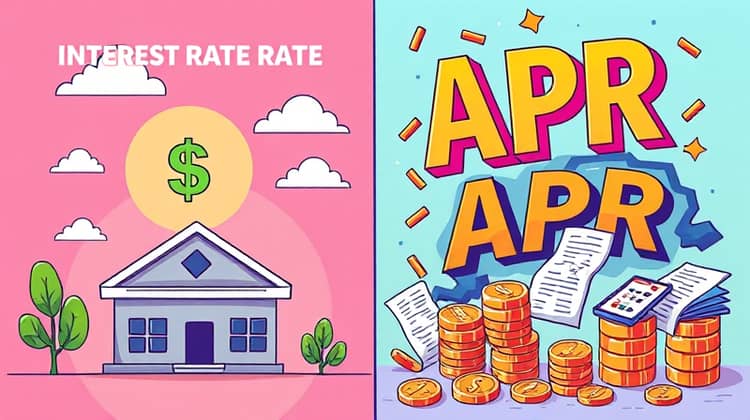APR vs. Interest Rate: Understanding the True Cost of Your Loan

When taking out a loan, understanding the financial terms associated with it is crucial. The two terms often thrown around are the interest rate and the APR, or Annual Percentage Rate. While they may seem similar at first glance, they represent different concepts that can significantly impact the total cost of the loan.
In this article, we will explore the differences between the interest rate and APR, clarify what they mean, and help you understand how they affect your loan repayment. We aim to provide you with the knowledge you need to make informed financial decisions, particularly when it comes to borrowing money.
What is Interest Rate?

The interest rate is the cost of borrowing money, expressed as a percentage of the total loan amount. It indicates how much you will pay the lender for the privilege of using their funds. Interest rates can vary based on several factors, including the lender's policies, the borrower's creditworthiness, and the economic climate.
Different types of loans may have different interest rates, and these can be fixed (meaning the rate remains the same throughout the life of the loan) or variable (meaning the rate can change over time). Knowing the interest rate of your loan is essential for calculating your payment obligations. To better understand interest rates, one must also consider the overall impact they can have on loan payments. It is not just the rate that matters but how this can add to the total cost of a loan over time.
- Interest rates represent the cost of borrowing money.
- They can be fixed or variable depending on the loan terms.
- Higher interest rates typically result in higher monthly payments.
- Credit scores can impact the interest rate offered to a borrower.
Understanding your interest rate can help you gauge your loan's cost and determine how it fits into your financial plans, but it is only part of the equation. The APR offers a more holistic view of the actual cost of your loan.
Understanding APR (Annual Percentage Rate)

APR stands for Annual Percentage Rate, and it includes not only the interest rate on your loan but also any associated fees or additional costs incurred over a year. This comprehensive rate provides borrowers with a clearer picture of the total cost of borrowing money, beyond just the interest alone.
By law, lenders are required to disclose the APR, allowing consumers to compare different loan offers more easily. Understanding APR is particularly beneficial when evaluating loans with different fees, which can greatly influence the overall price you pay for borrowing.
Knowing the APR can empower borrowers to make better-informed decisions when taking out loans, ensuring they understand the true financial commitment they are making. It converts all costs related to a loan into a single annualized figure. It is crucial for transitioning from simply looking at interest rates to a more comprehensive view of lending costs.
- APR encompasses the interest rate plus additional loan fees.
- It provides a broader understanding of the total borrowing cost.
- Loans with different fees should be evaluated on their APR for accurate comparisons.
- By comparing APRs, borrowers can identify the most cost-effective lending options.
Like the interest rate, the APR is a vital component of a loan agreement, yet its comprehensive nature gives it an edge in illustrating the overall financial obligations.
APR vs. Interest Rate: Key Differences

While interest rates and APR are both fundamental in understanding loans, they serve different purposes. The interest rate reflects the core cost of borrowing the money, while the APR provides a more rounded perspective by including fees and other costs associated with the loan.
Because the APR takes into account various factors, it is often seen as a more reliable indicator when comparing loan offers. Simply choosing the loan with the lowest interest rate could lead to unpleasant surprises if there are hidden fees which inflate the actual cost of borrowing.
- The interest rate only covers the cost of borrowing the principal amount.
- APR includes the interest rate and additional fees, offering a holistic view.
- APR is particularly useful for comparing different loans side by side.
- Interest rates may vary over the life of a loan, while APR offers a stable annualized rate.
These distinctions are critical for ensuring that borrowers not only understand how much they will pay over time but also what loans to accept based on their unique financial situations.
Why APR is Important

APR is a significant figure for borrowers to consider, as it reflects the overall cost of borrowing and allows for better financial decision-making. By understanding APR, individuals can more effectively budget for loan repayments and avoid unexpected costs that could arise from lower-than-expected interest rates concealed within fees.
Having a grasp on the APR enables borrowers to compare multiple lenders and loan products more efficiently. A higher APR often indicates that borrowing costs will be greater over time, which could lead to paying thousands more in interest and fees if not properly evaluated.
Overall, knowing the APR helps consumers avoid pitfalls that could stem from solely focusing on the interest rate. It enhances financial literacy and encourages individuals to scrutinize loan terms thoroughly before making a commitment.
How to Calculate APR

Calculating APR can seem daunting, but it’s quite straightforward with the right formula. Here’s a simple method to calculate your loan's APR accurately.
- Identify the total cost of the loan, including interest and fees.
- Determine the payment schedule (monthly, bi-weekly, etc.).
- Use the formula: APR = (Total Interest + Fees) / Principal Loan Amount x 100.
- Adjust the result to reflect an annual basis, if needed.
It is wise to be mindful that various factors may influence APR, including loan duration, the payments frequency, and the applicable rates. You may want to use an online calculator or consult with your lender for assistance in receiving precise calculations tailored to your circumstances.
When is Interest Rate More Useful?

Interest rates becoming more useful is when comparing loans that have similar terms and no additional fees. If two loans are substantially alike in structure, the interest rate might be a sufficient indicator of the total cost of borrowing.
Moreover, interest rates become relevant in fixed-rate loans where they confirm what you will pay without concern for fluctuations or hidden fees commingling with APR. Understanding interest rate helps to provide clarity when borrowers want to assess their potential monthly payments more specifically.
Conclusion

To sum up, understanding the difference between interest rate and APR is essential for any borrower. The interest rate tells you the basic cost of borrowing, but the APR gives you a complete picture of the overall expense you will incur over the life of the loan.
By analyzing both figures, you can make more informed decisions regarding which loan products to choose, thus better managing your finances and minimizing costs.
Therefore, take time to familiarize yourself with APRs and interest rates before signing any loan agreements, as this knowledge empowers you to secure the best loan for your financial needs.






